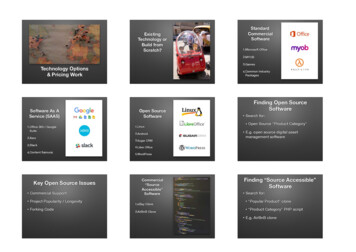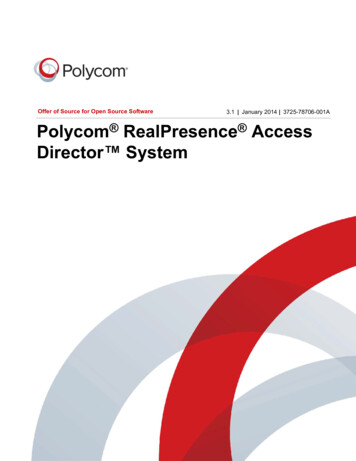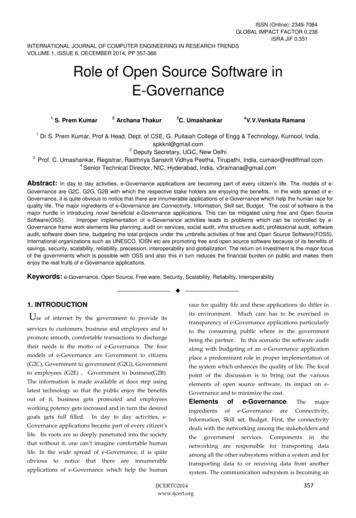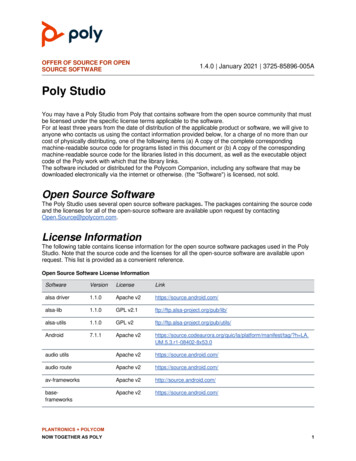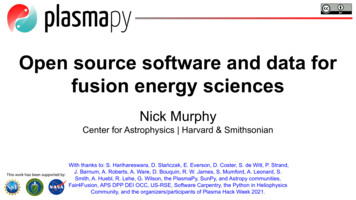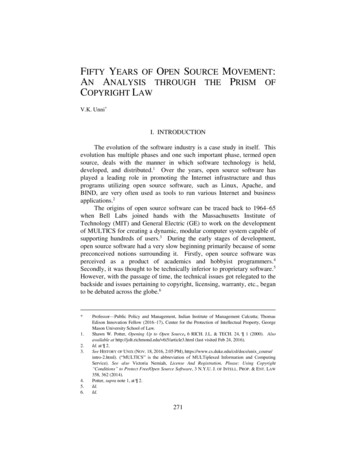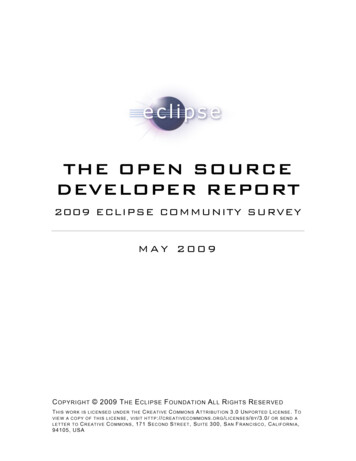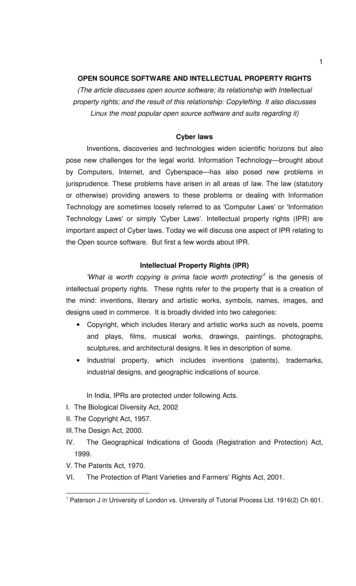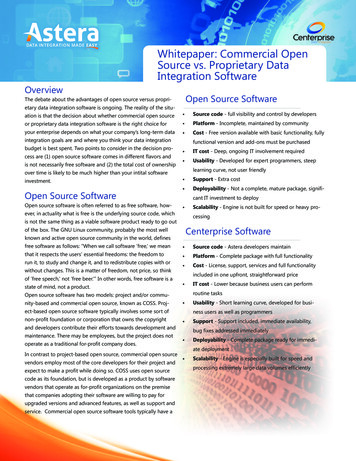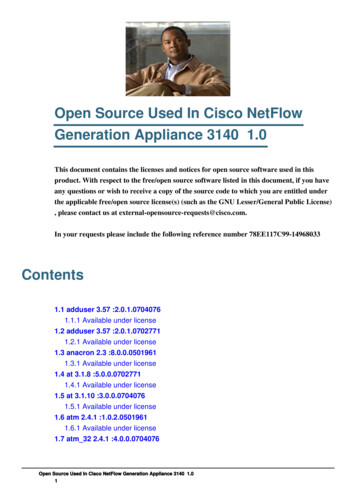
Transcription
International Journal of Emerging Trends & Technology in Computer Science (IJETTCS)Web Site: www.ijettcs.org Email: editor@ijettcs.org, editorijettcs@gmail.comVolume 1, Issue 3, September – October 2012ISSN 2278-6856Free and Open Source Software: Evolution,Benefits and CharacteristicsMurtaza Ali Khan1 and Faizan UrRehman21,2Umm Al-Qura University,College of Computer and Information System,Makkah, Saudi ArabiaAbstract: The emergence of the Free and Open SourceSoftware (FOSS) is an important frontier of InformationSystems. The impact of FOSS on society, business, education,and research is rising. Thus, there is a need of clearunderstanding of the meaning and characteristics of Freeand Open Source Software. In this paper, we briefly reviewedthe evolution of FOSS and elaborated the terms FreeSoftware and Open Source Software. We discussed thebenefits of Free and Open Source Software such ascommunity support, cost, security, education and research.We mentioned widely used FOSS licenses. We discussed theunique characteristics of FOSS; this includes communitybased distributed development, modularity, reusability,distribution, and reward mechanisms. Moreover, wediscussed the future trends and directions of Free and OpenSource Software.Keywords: Community Project, Free and Open SourceSoftware, Software Licenses, Software Model.1. INTRODUCTIONFree and Open Source Software (FOSS) grants the usersthe right to run the software, inspect, modify, anddistribute the source-code/software. Today millions ofusers all over the world are using the FOSS. Both thenumber of users and the number of FOSS are increasingday by day. As of June 2012, SourceForge, a repository ofopen-source projects, lists more than 324,000 projects andmore than 3.4 million developers [20]. Note that 3.4million are number of developers, number of users are farexceeding than this number. Taken an example ofsoftware, VLC media player, is downloaded 3,638,818times from the SourceForge in only one week of June2012 [23]. The same software (VLC) is available todownload from many other websites too. These figuresgive an idea of growth and wide spread usage of FOSS.Almost in every domain of applications FOSS alternativesof proprietary software are available. To name a few,operating system (Linux), office suite (LibreOffice),database (MySQL), browser (FireFox), image processing(GIMP), media player (VLC), animation (Blender), etc.FOSS especially Linux have forever changed thecomputing world. During the period of around threedecades, FOSS phenomenon has undergone a significantVolume 1, Issue 3 September-October 2012transformation, from the question of survival tochallenging tycoons of proprietary and closed sourcesoftware. With the passage of time, commercialopportunities of Free and Open Source Software aregrowing. Due to immense impact of Free and OpenSource Software on business, education, science &technology, etc., it is important to better understand thehistory, definition, characteristics, and future directions ofFOSS, which is the main goal of this paper.Organization of the rest of the paper is as follows:Evolution of FOSS is reviewed in Section II. Free andOpen Source Software are formally defined in Section III.In Section IV, we discussed the benefits of FOSS. Themost common licenses of FOSS are listed in Section V.Section VI discusses the main characteristics of FOSS.The future of FOSS is discussed in Section VII.Concluding remarks are in Section VIII. Appendix Agives the criteria set by Open Source Initiative that thedistribution terms of open-source software must comply.A selective list of historically significance Free and OpenSource Software with brief detail of each is provided inAppendix B.2. EVOLUTION OF FREE AND OPENSOURCE SOFTWAREThe concept of sharing computer programs (software) isvery old, dated back to 1960s. In the early period most ofthe computer programs were written by academics andresearchers. At that time it was common to share sourcecode and its binary form under the principles of opennessand cooperation. In fact, in the beginning, there was onlyfree (libre) software. Later on, proprietary software wasborn [30]. The two significance contributions to theevolution of Free and Open Source Software are GNUProject and Open Source Initiative.2.1 GNU ProjectIn 1983, Richard Stallman, formerly a programmer at theMIT AI Lab, launched the GNU Project to write acomplete operating system free from constraints on use ofits source code [21]. The GNU Project began working onan operating system called GNU ("GNU" is a recursiveacronym that stands for "GNU's Not Unix"). This goal ofmaking a Free Software operating system was achieved inPage 1
International Journal of Emerging Trends & Technology in Computer Science (IJETTCS)Web Site: www.ijettcs.org Email: editor@ijettcs.org, editorijettcs@gmail.comVolume 1, Issue 3, September – October 2012ISSN 2278-68561992 when the last gap in the GNU system, a kernel, wasfilled by the third-party Linux kernel being released asFree Software [21]. In 1989, the first version of the GNUGeneral Public License was published [8]. Thewidespread availability of the Internet in the 1990sgreatly contributed to the propagation of FOSS.2.2 Free Software Foundation (FSF)The Free Software Foundation, founded by RichardStallman in 1985. FSF is a non-profit organization with aworldwide mission to promote computer user freedomand to defend the rights of all Free Software users [5].The Free Software Foundation (FSF) is best known for itssponsorship of the GNU project [15]. The FSF maintainshistoric articles covering Free Software philosophy andmaintains the Free Software Definition — to show clearlywhat must be true about a particular software program forit to be considered as Free Software [5]. The FSFpublishes the GNU General Public License (GNU GPL),GNU Lesser General Public License (GNU LGPL), theGNU Affero General Public License (GNU AGPL) andthe GNU Free Document License (GNU FDL). The FreeSoftware Foundation (FSF) distributes the GNU CompilerCollection (GCC). GCC is a compiler system supportingvarious programming languages such as C, C ,FORTRAN, Java, Ada, Go, etc.2.3 Open Source Initiative (OSI)The Open Source Initiative (OSI) is a non-profitcorporation with global scope formed to educate aboutand advocate for the benefits of open source and to buildbridges among different constituencies in the open sourcecommunity [18]. The organization was founded inFebruary 1998, by Bruce Perens and Eric S. Raymond,prompted by Netscape Communications Corporationpublishing the source code for Netscape Communicator(Internet suite).3. FREE AND OPEN SOURCE SOFTWARE“free beer” . [5].3.2 Open Source SoftwareOpen-source software (OSS) is computer software that isavailable in source code form: the source code and certainother rights normally reserved for copyright holders areprovided under an open-source license that permits usersto study, change, improve and at times also to distributethe software. Open Source Initiative defines the criteriathat the distribution terms of open-source software mustcomply [16] (see the Appendix A).3.3 Free and Open Source SoftwareNow after defining the terms Free Software and OpenSource Software separately, the unified term Free andOpen Source Software (FOSS) refers to software that isboth Free as defined by FSF and Open Source asadvocates by OSI. Nevertheless in literature the termsFree Software and Open Source Software are usedinterchangeably.Appendix B provides brief details of selected softwarethat have historical significance in the development ofFOSS. Table 1 gives a typical comparison between ClosedSource Propriety Software (CSPS) and Free and OpenSource Software (FOSS).Table 1: Comparison between Closed Source ProprietySoftware (CSPS) and Free and Open Source Software(FOSS).CSPSFOSSUser can run the software Source code is available to userMultiple users on multiplemachines are allowed User can modify the source codeUser can redistribute the software FeatureNow after describing the GNU Project and Open SourceInitiative we can formally define the terms Free Softwareand Open Source Software. It is important to note thatthese terms emerged separately. The FSF stands behindthe term Free Software, while the OSI is advocates of theterm Open Source Software.4. BENEFITS OF FREESOURCE SOFTWARE3.1 Free SoftwareThe Free Software Foundation defines the Free Softwareas follows: “Free software” means software that respectsusers' freedom and community. Roughly, the users havethe freedom to run, copy, distribute, study, change andimprove the software. With these freedoms, the users(both individually and collectively) control the programand what it does for them . [5]. Thus, “free software” isa matter of liberty, not price. To understand the concept,you should think of “free” as in “free speech,” not as in4.1 Community SupportThere is a very large community of volunteers whosupport and promote Free and Open Source Software [6].Online message-boards and mailing-lists are essentialpart of FOSS projects. If a user/developer of FOSS has aquestion or trouble he/she can post the message onmessage-board or send an email to the mailing-list.Volunteers willing to help respond by answering thequestion and debugging the problem. A common trend isto publish Frequently Ask Questions (FAQs) on the FOSSVolume 1, Issue 3 September-October 2012ANDOPENThe following reasons contribute to increasing interest inthe Free and Open Source Software:Page 2
International Journal of Emerging Trends & Technology in Computer Science (IJETTCS)Web Site: www.ijettcs.org Email: editor@ijettcs.org, editorijettcs@gmail.comVolume 1, Issue 3, September – October 2012ISSN 2278-6856project page. These FAQs are very helpful to solve theproblems of many users.4.2 CostTypically a propriety software license requires paying aseparate fee for each machine or each user. Even though,information, like a computer program, once it is created,is practically costless to reproduce [31]. Almost all of theFree and Open Source Software have no buying orlicensing cost. Moreover, user has no restriction to makemultiple copies of FOSS for multiple users or multiplemachines. This provides an obvious incentive for theadoption of Free and Open Source Software to individualsand businesses.4.3 SecurityFree and Open Source Software are more secure becausetheir source code is available for scrutiny to largecommunity. Bugs and security issues are identified andfixed easily and quickly. Security threats such as viruses,worms, Trojans and malware are common to Windowsoperating systems but very uncommon to Free and Opensource Linux operating system.4.4 Education and ResearchFree and Open Source Software are well suited foreducation and research. The cost to obtain, install andmaintain the FOSS is very low and in some cases zero.The source code of FOSS can be inspect and modify, thisis very useful for research purposes. Derivate software canbe written using FOSS code without any copyright issues.Academic, students and researchers can freely share theirwork. Usage of Linux operating system in educationaland research institutes is highly recommended. Thevariety of tools and compilers available on Linuxoperating system makes it an ideal platform for teachingcourses in computer science and engineering. Excellentfree compilers are available for C, C , Objective C,Java, Pascal, FORTRAN, Modula-2 and -3, Ada, andEiffel [17].5. FOSS LICENSESThe Free Software Foundation publishes lists of licenses.The most popular of these licenses are:a.GNU General Public License [7].b.FreeBSD License [4].c.Mozilla Public License [13].d.Apache License [1].e.X11 License (also known as MIT License) [28].We will not go into the details of these licenses. Forinterested user references of these licenses are provided.But it is important to note that these licenses are incompliances with “Free Software” definition andapproved by FSF and their source code is Open Source.With the evolution of FOSS, the FOSS licenses alsoVolume 1, Issue 3 September-October 2012evolved. Initially, it was difficult for business toincorporate FOSS with propriety code but now severallicenses permit this combination. By selecting appropriatelicense it quite possible to bundle the Free and OpenSource Software with the proprietary software. Licenses,like the BSD and MIT Licenses, are suitable for situationsin which originator wants wide spread deployment ofhis/her ideas regardless of in open source software orproprietary software. The wide ranges of FOSS licensesgive more flexibility to developers and distributors.6. CHARACTERISTICS OF FOSSThe development of open source software consists ofplanning, analysis, design, and implementation phases[3] as in any other software model. However, there areunique characteristics of FOSS. In this section, wedescribe the main characteristic of Free and Open SourceSoftware.Figure 1 Modular design approach of FOSS6.1 Community Based Distributed DevelopmentIn a typical FOSS, initially an individual or fewvolunteers involve in the project. Once the project isdebut and successful then a community of project isestablished. Later other members from the communitycontribute to the project. The Concurrent VersionsSystem (CVS) helps is distributed development of FOSS.CVS is a client-server software revision control system.CVS keeps track of all changes in a set of files, andallows several developers to collaborate. CVS itself is aFree and Open Source Software. Globally distributedsoftware development by virtual teams promises theflexibility, responsiveness, lower costs, and improvedresource utilization [14].6.2 Modular DesignIn modular design software architecture is divided intoPage 3
International Journal of Emerging Trends & Technology in Computer Science (IJETTCS)Web Site: www.ijettcs.org Email: editor@ijettcs.org, editorijettcs@gmail.comVolume 1, Issue 3, September – October 2012ISSN 2278-6856components called modules. Modular design supportsabstraction, increased understanding of the system andconcurrent development. Due to distributed nature ofFOSS, its design must be modular that can easilyincorporate into the main system. Modularity is favorablecharacteristics for open source production [10]. Modulardesign with well-defined interfaces helps in effectivecollaborative development of FOSS. Figure 1 shows themodular design approach of FOSS.6.3 ReusabilityReusability means segment of source code that can beused again to add new functionalities with little or nomodification. This fits very well the characteristics of theOpen Source production process [26]. FOSS licensesgrants the rights to the developer to obtain the sourcecode, inspect it, modify it, and distribute it. This meanFOSS licenses inherently encourages a developer to reusecode. The reuse of code can be either within the project oroutside the project, i.e., in other projects. A more detailsstudy with statistics of code reuse in open source softwareis conducted by [27]. FOSS repositories such asSourceForge offer huge amounts of reusable code.6.4 Distribution and LicensingInternet is the medium of distribution of Free and OpenSource Software. Download websites, mailing-lists, blogs,forums, etc., all contribute to the wide spread publicityand distribution of Free and Open Source Software. Wideranges of licensing options, such as GPL, LGPL, BSD,ISC, Artistic License, etc., are available for FOSSdistribution.6.5 Reward MechanismsAt the beginning of Free Software movement, seeminglyit was difficult to perceive the business opportunities ofFree and Open Source Software. But now business modelof FOSS is getting success. Sources of income range fromdonations to providing services such as consulting,integration, support and training. It also worth to mentionthat reward other than money, such as reputation andserving community is also important for many developers.7. FUTURE OF FOSSNow the Free and Open Source Software model hastransformed into a more mature form that is technicallysound and commercially viable. The market share ofFOSS is growing, e.g., International Data Corporation,the Q3 2011 Server statistics show that Linux serverrevenues grew up to 2.3 billion, a 12.3 percent increaseover the previous year [29].A wide range of Free and Open Source applications areavailable in various domains on various platforms. Infuture, new applications will develop particularly in therapidly growing market of smart-phones and tabletcomputers. Competition with commercial and closedVolume 1, Issue 3 September-October 2012source software will be more challenging for both sides.Based on the notion of survival of the fittest, dynamic,robust, competitive, secure, and user-friendly applicationswill capture the market. Businesses will rely more onproviding services related to Free and Open SourceSoftware. Free and Open Source Software offers muchmore revenue-generating opportunities than anticipatedin the past. It is safe to say that Free and Open SourceSoftware will an important factor in the InformationSystems of the future.8. CONCLUSIONIn this paper, we elaborated the meaning of Free andOpen Source Software. We described the evolution,benefits, characteristics, and future of Free and OpenSource Software (FOSS). We listed widely used FOSSlicenses. The wide ranges of FOSS licensing options givemore flexibility to developers and distributors. The widespread diffusion of the Internet and communicationtechnologies helped in the formation of communities.Role of communities is very significance in thedevelopment and use of Free and Open Source Software.The FOSS model is inherently collaborative andtransparent. Modular and distributed development is theimportant characteristics of Free and Open SourceSoftware. Free and Open Source Software model ensuressecurity, availability, reliability, quality, and efficiency ofsoftware development. The business opportunities of aregrowing. Sources of income range from donations toproviding services such as consulting, integration,support and training. Free and Open Source Software willplay a significant role in setting the tone and pace ofinformation systems of the future.References[1] The Apache Software Foundation, Apache /LICENSE-2.0,retrieved on 15 Jun 2012.[2] Roy T. Fielding and Gail E. Kaiser, “The apachehttp server project”, IEEE Internet Computing, vol.1, no. 4, pp. 88–90, 1997.[3] Brian Fitzgerald, “The transformation of opensource software”, MIS Quarterly, 30(3):587–598,2006.[4] The FreeBSD Project, The FreeBSD ight/freebsdlicense.html, retrieved on 15 Jun 2012.[5] org/, retrieved on 15 Jun 2012.[6] Alfonso Fuggetta, “Open source software - anevaluation”, Journal of Systems and Software, vol.66, pp. 77–90, 2003.[7] Free Software Foundation, GNU GENERALPUBLICLICENSE,Page 4
International Journal of Emerging Trends & Technology in Computer Science (IJETTCS)Web Site: www.ijettcs.org Email: editor@ijettcs.org, editorijettcs@gmail.comVolume 1, Issue 3, September – October 2012ISSN censes/gpl.html, retrieved on15 Jun 2012.GNU GENERAL PUBLIC LICENSE, Version nses/old-licenses/gpl-1.0.txt,retrieved on 17 Jun 2012.Nicolai Langfeldt, “The Concise Guide to DNS andBind”, Que Corp., Indianapolis, IN, USA, 2000.Josh Lerner and Jean Tirole, “Some simpleeconomics of open source”, Journal of IndustrialEconomics, Vol. 50, pp. 197–234, 2002.Marshall Kirk McKusick, Keith Bostic, Michael J.Karels, and John S. Quarterman, “The design andimplementation of the 4.4BSD operating system”,Addison Wesley Longman Publishing Co., Inc.,Redwood City, CA, USA, 1996.Audris Mockus, Roy T. Fielding, and JamesHerbsleb, “A case study of open source softwaredevelopment: the apache server”, In Proceedings ofthe 22nd international conference on Softwareengineering, ICSE ’00, pp. 263–272, New York,NY, USA, 2000. ACM.Mozilla Foundation, Mozilla Public License,available at: http://www.mozilla.org/MPL/2.0/,retrieved on 15 Jun ications of the ACM, vol. 40, pp. 30–37,1997.Richard Stallman, Free software foundation (FSF),Encyclopedia of Computer Science (book), JohnWiley and Sons Ltd, pp. 732–733, 2003.The Open Source Initiative (OSI), The Open .org/docs/osd, retrieved on 15Jun 2012.Shahid H. Bokhari and Rafeequr Rehman, "Linuxand the developing world", IEEE Software, vol. 16,no. 1, pp. 58–64, 1999.The Open Source Initiative (OSI), available at:http://opensource.org/, retrieved on 15 Jun 2012.Robert W. Scheifler and Jim Gettys, “The X windowsystem”, ACM Trans. Graph., 5(2):79–109, April1986.SourceForge, a repository of open-source projects,available at: http://sourceforge.net/about, retrievedon 17 Jun w.gnu.org/gnu/thegnuproject.html, 2002.StatCounter, available at: http://gs.statcounter.com,retrieved on 15 Jun 2012.SourceForge, VLC media player, available at:http://sourceforge.net/projects/vlc/?source directory,retrieved on 18 Jun 2012.Linus Torvalds, “The Linux Edge”, Commun. ACM,42(4):38–39, April 1999.Michael Widenius and Davis Axmark, MysqlReference Manual, O’Reilly & Associates, Inc.,Sebastopol, CA, USA, 1st edition, 2002.Volume 1, Issue 3 September-October 2012[26] Andrea Bonaccorsi and Cristina Rossi, "Why OpenSource software can succeed", Research Policy, vol.32, no. 7, pp. 1243–1258, 2003.[27] Stefan Haefliger, Georg von Krogh, SebastianSpaeth, “Code Reuse in Open Source Software”,MANAGEMENT SCIENCE, vol. 54, no. 1, pp.180–193, 2008.[28] .6/COPYRIGHT2.html#3, retrieved on 15 Jun 2012.[29] International Data Corporation, available at:http://www.idc.com/getdoc.jsp?containerId prUS23179011, retrieved on 15 Jun 2012.[30] A brief history of open source software, available at:http://eu.conecta.it/paper/brief history open source.html#foot191, retrieved on 17 Jun 2012.[31] Mikko Mustonen, Copyleft-the economics of Linuxand other open source software, InformationEconoimics and Policy, vol. 15 pp. 99–121, 2003.APPENDIX AThe following definition of Open Source is taken from ource.org/docs/osd)The Open Source DefinitionIntroductionOpen source doesn't just mean access to the source code.The distribution terms of open-source software mustcomply with the following criteria:1Free RedistributionThe license shall not restrict any party from selling orgiving away the software as a component of an aggregatesoftware distribution containing programs from severaldifferent sources. The license shall not require a royaltyor other fee for such sale.2Source CodeThe program must include source code, and must allowdistribution in source code as well as compiled form.Where some form of a product is not distributed withsource code, there must be a well-publicized means ofobtaining the source code for no more than a reasonablereproduction cost preferably, downloading via the Internetwithout charge. The source code must be the preferredform in which a programmer would modify the program.Deliberately obfuscated source code is not allowed.Intermediate forms such as the output of a preprocessor ortranslator are not allowed.3Derived WorksThe license must allow modifications and derived works,and must allow them to be distributed under the sameterms as the license of the original software.4Integrity of The Author's Source CodePage 5
International Journal of Emerging Trends & Technology in Computer Science (IJETTCS)Web Site: www.ijettcs.org Email: editor@ijettcs.org, editorijettcs@gmail.comVolume 1, Issue 3, September – October 2012ISSN 2278-6856The license may restrict source-code from beingdistributed in modified form only if the license allows thedistribution of "patch files" with the source code for thepurpose of modifying the program at build time. Thelicense must explicitly permit distribution of softwarebuilt from modified source code. The license may requirederived works to carry a different name or versionnumber from the original software.FOSS5No Discrimination Against Persons or GroupsThe license must not discriminate against any person orgroup of persons.6No Discrimination Against Fields of EndeavorThe license must not restrict anyone from making use ofthe program in a specific field of endeavor. For example,it may not restrict the program from being used in abusiness, or from being used for genetic research.BSDUnix7Distribution of LicenseThe rights attached to the program must apply to all towhom the program is redistributed without the need forexecution of an additional license by those parties.8License Must Not Be Specific to a ProductThe rights attached to the program must not depend onthe program's being part of a particular softwaredistribution. If the program is extracted from thatdistribution and used or distributed within the terms ofthe program's license, all parties to whom the program isredistributed should have the same rights as those that aregranted in conjunction with the original softwaredistribution.9License Must Not Restrict Other SoftwareThe license must not place restrictions on other softwarethat is distributed along with the licensed software. Forexample, the license must not insist that all otherprograms distributed on the same medium must be opensource software.10 License Must Be Technology-NeutralNo provision of the license may be predicated on anyindividual technology or style of interface.APPENDIX BTable 2 provides brief details of selected software thathave historical significance in the development of onTable 2: Table 2. The table below shows historical FOSSsoftwareFOSSDescriptionLicenseGNULinuxis a Unix-like operating system. Itis one of the most successful Freeand Open Source Software. Thecore component of Linux is theGNUGeneralPublicLicenseVolume 1, Issue 3 September-October 2012MySQLDescriptionLinux kernel, first releasedOctober 5, 1991 by LinusTorvalds. Linux today hasmillions of users, thousands ofdevelopers, and a growing market[24].is a Unix like operating systemdeveloped and distributed by theComputer Systems ResearchGroup (CSRG) of the Universityof California, Berkeley, from1977 to 1995. BSD Unix becamethe basis for many commercialversions of Unix and dominatedthe commercial Unix marketuntil the 1990s. Today, BSD isfound in nearly every variant ofUNIX, and is widely used forInternet services and firewalls,time-sharing,andmultiprocessing systems [11]is a computer software systemthat provides high performance,high-level,device-independentgraphics [19]. For long time itremained the de facto system forthe GUI based Unix workstations.X originated at the MassachusettsInstitute of Technology (MIT) in1984.CurrentlyX.OrgFoundation leads the project of XWindowSystem.Website:http://www.x.org/is an implementation of theDomain Name System (DNS)protocols. DNS is a distributedInternet directory service. It isused mainly to translate betweendomain names and IP addresses,and to control Internet emaildelivery [9]. BIND was firstreleased with Berkeley SoftwareDistribution 4.3BSD. As of 2012,the Internet Systems Consortium(ISC) maintains bindis multi-threaded, multi-user, andSQL(StructuredQueryLanguage) database server. It isthe most popular SQL database inthe open source community andis used almost universally by websites running on open icenseMITLicenseISClicenseGNUGPL orproprietaryEULAPage 6
International Journal of Emerging Trends & Technology in Computer Science (IJETTCS)Web Site: www.ijettcs.org Email: editor@ijettcs.org, editorijettcs@gmail.comVolume 1, Issue 3, September – October 2012ISSN tionis web server software. It is themost popular web server softwarein the world. Apache began inFebruary 1995 as a combinedeffort to coordinate existing fixesto the NCSA httpd program [12,2].Website:http://httpd.apache.org/is a web browser managed byMozilla Foundation. FireFox hasapproximately 25% of worldwideusage share of web browsers [22].The FireFox project began as anexperimental branch of theMozilla project by Dave Hyatt,Joe Hewitt and Blake LicenseunderApacheLicenseGNUGPL orGNULGPLVolume 1, Issue 3 September-October 2012Page 7
mber-October 2012Page 7
that the distribution terms of open-source software must comply [16] (see the Appendix A). 3.3 Free and Open Source Software Now after defining the terms Free Software and Open Source Software separately, the unified term Free and Open Source Software (FOSS) refers to software that is both Free as defined by FSF and Open Source as
